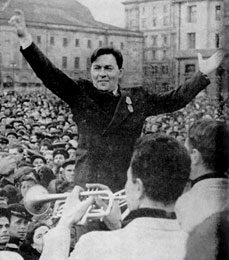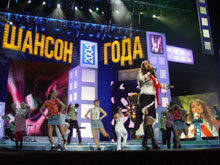Russian shanson is a uniquely Russian cultural phenomenon. A traditionally rebellious musical genre, which has a reputation for describing the darkest parts of life in Russia, became widely popular during the Soviet era, despite being effectively banned in the USSR. It has now moved from its underground existence to mainstream Russian culture. There are radio stations and a satellite TV station devoted to it and a yearly awards ceremony to honor its artists – held inside the Kremlin, in the very building where Soviet lawmakers once met.

Throughout the 20th century and into the 21st, “Russian shanson,” has evolved to encapsulate several sub-genres. Currently, “shanson” is the popular commercial tag, but before the 1980s, this name was not prevalent in Russia. The term may have been applied first in France by locals listening to the music of Russian political émigrés in the early 1900s. The French “chanson,” translates simply as “song,” though is itself a genre of free-verse songs. Others argue that the term was first applied by Russian record producers in the 1980s, who adopted the French word (in slightly corrupted form) in an attempt to increase the mystique of the albums they were hoping to sell. In any case, the music is distinctly Russian and therefore it is perhaps best to use the term “shanson,” a direct transliteration from the Russian “шансон” rather than the word originally borrowed from the French.
Before Russia’s post-perestroika music industry began using the term widely and consistently, “shanson” in Russia existed as at least two separate genres – which would mix to form today’s shanson. The milder of the genres includ “street genre” (уличный жанр) or “neighborhood romance” (дворовый романс – note that “дворовый” would actually translate to “courtyard,” a common fixture of Soviet-built housing communities). These songs are created and performed by amateur singer/songwriters who would sing about their lives, love, current events, and everything else that affected the Soviet communities. Their music usually includes the guitar, which they play themselves. This music was characterized by its emotional, romantic, and/or comical text and presentation.
Some singers of street genre rose to stardom under the communists, raised by both popular public support and recognition from the Soviet authorities as being a sort of genuine “people’s music,” so long as the songs avoided politics or supported Soviet ideals. Artists such as Leonid Utesov, Alexander Vertinsky, and Vadim Kozin largely defined popular culture in the 1920s, 30s, and 1940s, not only producing songs, but also often starring in films and participating in other cultural events.

The other, darker parent of shanson was the “blatnaya song” (блатная песня). “Blat” is a Russian word that refers to the complex system of personal connections and exchanges of favors that provided the basic foundation for everyday interaction between the Soviet government and its citizens. In its adjectival form the word can refer to just about anything criminal. These songs would tell of the lives of thieves, counterfeiters, petty and hardened criminals, and political dissidents, often tracing the fate of an individual from being arrested to being sent to jail or to labor in Siberia’s Gulags. They are often told from the first person, with the hero reminiscing about his/her former lifestyle, current situation, and of being freed and returning to society.
It is from the blatnaya song that Shanson takes much of its distinctive lingo and much of its reputation. Throughout the communist era, millions upon millions of people were “sent off” to Siberia. There, the terminology of this unique music was developed from a prison slang that had been developed from centuries before. Those men and women who returned from the Gulags often continued to sing, bringing the music back to the city masses. Some listeners were shocked and confused by the complex slang, but many others found it appealing, and as the popularity grew, the underground genre mixed with the more mainstream ones.
A generation of singers in the 1960’s and 70’s sang in a style often called “author-songs” (авторские песни) or “bardic songs” (бардовские песни), which presented often highly intellectual and highly politicized songs that showed characteristics of both street genre and blatskaya songs. Although the artists were not given state resources to further and spread their art, the art spread quickly anyway, recorded and copied via recently-introduced personal cassette recorders.
One of the most talented performers of this genre, Vladimir Vysotsky, was an actor of stage and screen who began performing music on the side. Although much of his work could be classified as either blatnaya or as street genre, he is most known in Russia as a performer of bardic songs. He is perhaps Russia’s most beloved singer of the modern era. His songs combined intelligence, originality, and unbelievable emotion and strength; his rough voice and acoustic guitar style are still instantaneously recognized by millions of Russians around the world, and imitated by thousands of musicians, both amateur and professional.

Arcady Severny, although not as widely popular as Vysotsky, was a contemporary of Vysotsky and is generally recognized as one the first big stars of the shanson genre. Some even think he was the first to use the term “shanson” as the name of a genre. With his distinctly masculine, crooning voice, gypsy-influenced styling, and his rebellious topics and lyrics, Severny became extremely popular through his semi-legitimate “apartment concerts.”
Both of these artists, although they never enjoyed state support or official recognition for their work, were widely popular even among politicians and party members. It is even said that Leonid Brezhnev preferred to listen to Vysotsky while flying in the USSR’s version of Air Force One. Both Vysotsky and Severny abused alcohol and died at a relatively young age, but they also established the intellectual credibility of shanson as an artistic medium.
After the breakup of the Soviet Union, shanson officially entered mainstream culture and Russia’s new capitalists attempted to capitalize on the already widespread demand for the music of shanson. In addition, many historians of Russian pop culture point to the growth of prison populations and crime rates in the 1990s and early 2000s that coincided with a wide popularization of criminal culture. TV miniseries such as Brigada showed criminals in a positive light. It was also at this time that Russia was widely introduced to American rap music, with which shanson is often compared in its tendency to celebrate criminal life. Other items openly associated in Russia with the world of crime such as ostentatious gold jewelry and watches, leather jackets, and black BMWs also became fashionable.
The marketing of shanson music also became tailored for an ever-wider audience that included many who had only recently developed a taste for the genre. Serial editions of “Legends of Shanson” sold well, even if many of the musicians featured on them were relatively unknown in shanson circles. It can also be said that as the genre became popularized and commercialized, the lyrical focus on creative and intelligent social commentary was replaced by the shock value of “blat” themes and language.
The unity of the shanson and criminal worlds is perhaps best exemplified by the life and death of Mikhail Krug. Known for his expressive, soulful voice, and tendency to sing about even the most controversial subjects in songs riddled with prison slang, he became one of the most popular shanson stars in his time. He sold millions of CDs and earned the nickname “The King of Shanson.” However, his ties to criminal gangs were also widely known and his life and a skyrocketing career were cut short when he was murdered in his own house. Although no perpetrator was ever found, many assume from the horrific nature of the murder that it was likely committed by gangsters that Krug had somehow angered. His death, however, only solidified his place in the history of Russian pop culture – and helped launch the career of Irina Krug, his widow, when she released an album of love songs dedicated to her late husband.

Radio stations specializing in playing Shanson long indulged their listeners with controversial songs featuring obscene language. Recently, however, this has started to change. In Kiev, the station “Russian Shanson” was the station of choice for public transportation drivers, meaning that most of the city’s population was listening to its broadcasts at some time during the day. After many complaints followed about the explicit language content, city officials were obliged to ban the genre from being played by drivers. In Yekaterinburg, Russia, a destination city for many ex-convicts freed from the large penitentiaries in the Urals and which is a stronghold of shanson, the same problem occurred, with the same solution decreed by officials. These controversies, in addition to pressures exerted from an increasingly conservative public and advertiser base, are prompting stations to alter their playlists.
The public is beginning to prefer a less-criminal influenced brand of shanson. Andrei Bandera has a style much closer to pop than many hard-lined Shanson lovers would like. Bandera’s voice is smooth and affectionate. His songs are primarily lyrical, include tender melodies, and concentrate mostly on praising the beauty of Russian nature and women. Currently, however, he is the most requested singer on Radio Shanson in Moscow. Mikhail Shufutinsky, recognized by many as the current “King of Shanson,” still carries the rough voice associated with shanson, but focuses on songs about love and patriotism, remaking classic bardic songs, and even occasionally singing about Jewish themes (he himself is Jewish).
The history of Russian shanson has been a long and at times less-than-illustrious one. It is a history, however, that many Russians associate with their own, therefore considering shanson to be a truly Russian art. The genre will likely continue to change to reflect the vast changes that are occurring in Russia itself, to stay fresh with its changing experiences of its listener base.











